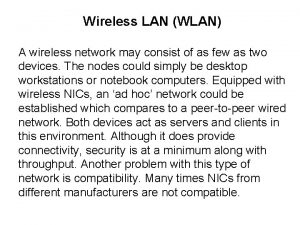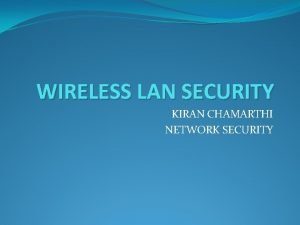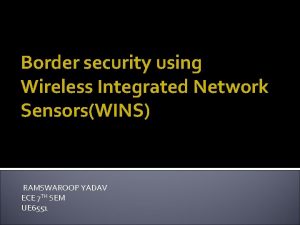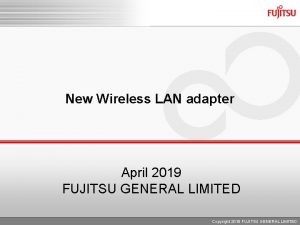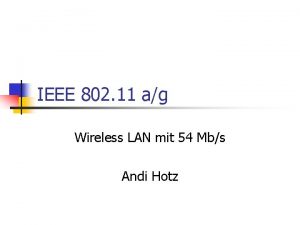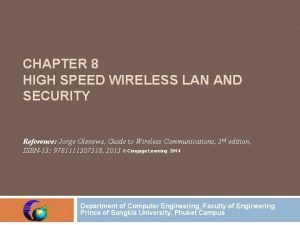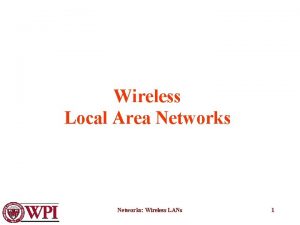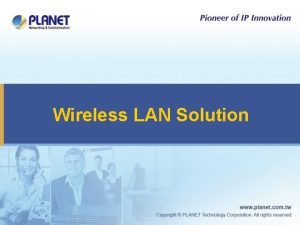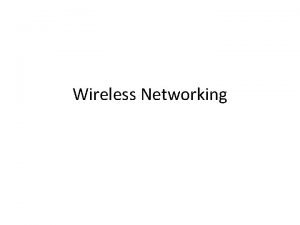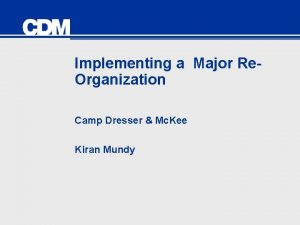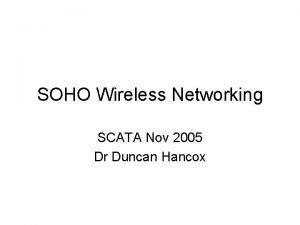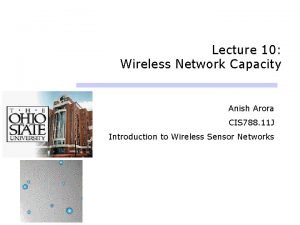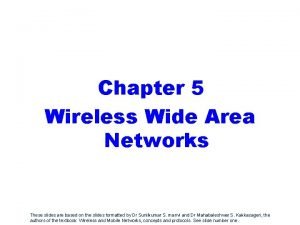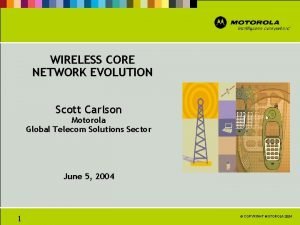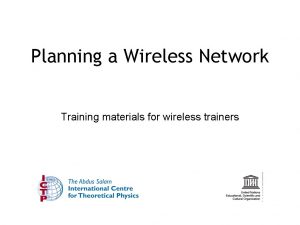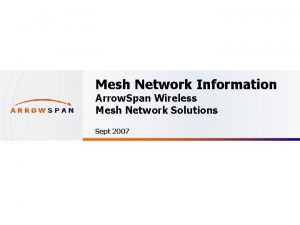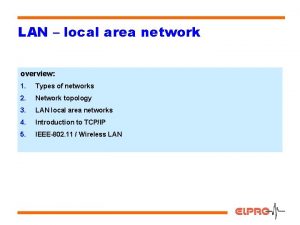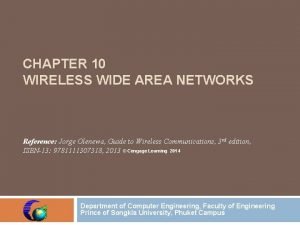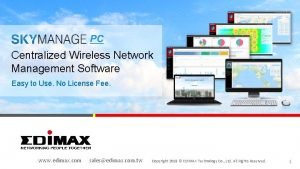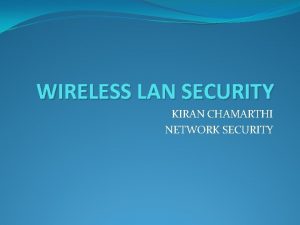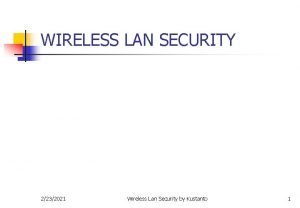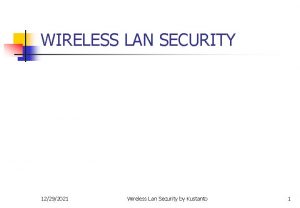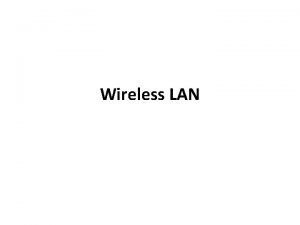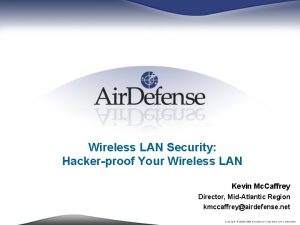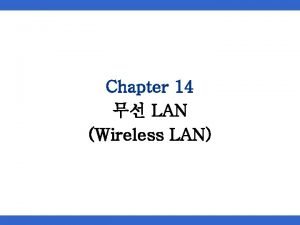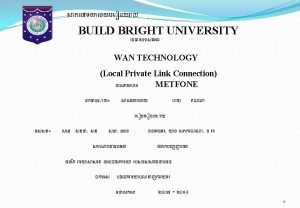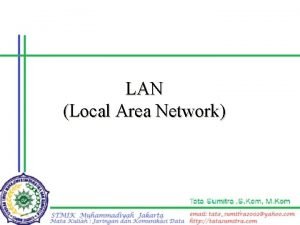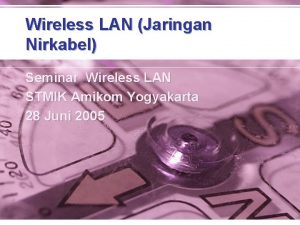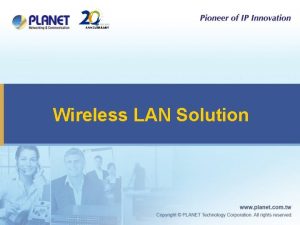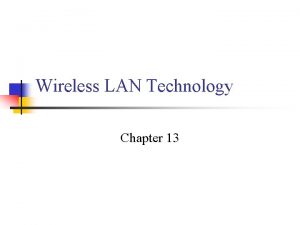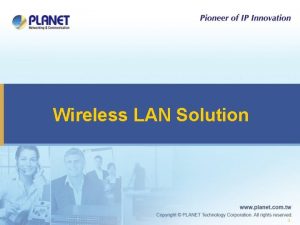WIRELESS LAN SECURITY KIRAN CHAMARTHI NETWORK SECURITY Definition










































- Slides: 42

WIRELESS LAN SECURITY KIRAN CHAMARTHI NETWORK SECURITY

Definition WLAN is a local area network that uses radio communication to provide mobility to the network users, while maintaining the connectivity to the wired network. A WLAN typically extends an existing wired local area network. WLANs are built by attaching a device called the access point (AP) to the edge of the wired network. Clients communicate with the AP using a wireless network adapter which is similar in function to a traditional Ethernet adapter.


What is Access Point? � WLAN transmits over the air by using the radio waves that travel between the client and the access point. � Wireless access points (APs or WAPs) are specially configured nodes on wireless local area networks (WLANs). Access points act as a central transmitter and receiver of WLAN radio signals.

What is BSS? � WLAN uses spread spectrum technology that is based on radio waves to enable communication between devices in a limited area, also known as Basic Service Set. � Network security remains an important issue for WLANs. Random wireless clients must usually be prohibited from joining the WLAN.

Standard for Wireless LAN �The IEEE standard which describes wireless LAN is 802. 11 �Evolution of WLAN Security: 1997 the original 802. 11 standard only offers - SSID (Service Set Identifier) - MAC Filtering (Media Access Control) - and WEP (Wired Equivalent Privacy) 1999 several industry players forms WECA (Wireless Ethernet Compatibility Alliance) for rapid adaption of 802. 11 network products. 2001 Fluhrer, Mantin and Shamir had identified some weaknesses in WEP. IEEE started Task Group i. 2002 WECA was renamed as WI-FI

2003 Wi-Fi introduced the Wi-Fi Protected Access (WPA). - Should be an interim solution for the weakness of WEP. 2004 The WPA 2 was introduced. - It based on the final IEEE 802. 11 i standard.

Components � Wireless Access Point � Wireless Network Card � Wireless Bridge � Antenna

Wireless Access Point � An AP is often a hardware device (but it can also be software based) that connects wireless communication devices. � WAP is used to relay the data between wireless networks and wired network devices and other wired network resources. � AP is a two-way transceiver that broadcasts data within a specific frequency spectrum. AP also performs security functions such as authentication and encryption for the wireless clients and data transmission through the wireless network.

Wireless Network Card(NIC) � A device such as a workstation or laptop requires a NIC to connect to the wireless network through radio waves. � The NIC scans the available frequency spectrum for connectivity and associates the spectrum to an AP.

Wireless Bridge � They are optional components that are used to connect multiple LANs at the MAC – layer level. � They can be used in building-to-building wireless scenario, because they can cover longer distances.

Antenna � The function of an antenna is to radiate the modulated signal through the air so that wireless clients can send and receive transmissions. � They are required on both AP and the wireless client.

WLAN Security The Security of WLAN can be divided into two main components: � Authentication: Strong authentication mechanisms enforce access control policy to allow authorized users to connect to the wireless network. � Encryption: Data encryption helps ensure that only authorized recipients understand the transmitted data.

Features to Secure WLAN � SSID � MAC Authentication � Client Authentication � Static WEP � WPA, WPA 2 and 802. 11 i � 802. 1 x and EAP � WLAN NAC � WLAN IPS � VPN IPsec

Service Set Identifiers � SSID is an arbitrary ID or name for a wireless LAN network that logically segment the subsystem i. e. an SSID is used to identify WLAN network and provide access for a device to join the network. � Although SSID does not act as security mechanism to provide data privacy or authentication , it can be used to prevent unauthorized access to clients that do not have a valid SSID to connect. � So in order to get configured to WLAN each client should be configured with the correct SSID.

MAC Authentication � MAC authentication allows the network access to known MAC addresses. � The access point verifies the client MAC address against a locally configured list of allowed addresses or against an external authentication server. � Access points can be preconfigured with all the wireless client MAC addresses in the MAC table that is maintained on the access point. � When a client requests association to the access point, the MAC table is checked, and if the MAC address of the client matches, the authentication is successful. The client is associated to the access point and can transmit data through the AP. � Note that the MAC authentication feature can be easily circumvented by using a MAC spoofing technique.

Client Authentication � 802. 11 support following Client authentication mechanisms : � Open Authentication: -authenticates anyone who requests it. -provides a null authentication process. -In addition to an SSID , open authentication can be implemented to provide an additional layer to the access control on the access point. Initiator Authentication request Responder Authentication response Open authentication involves WEP keys which allow authorized clients with correct WEP key to associate with access points and transmit data.

� Shared – key authentication: -Shared key authentication is similar to Open authentication in which it uses a WEP key along with SSID, but in this case the access point sends the client a challenge packet. The client replies to the challenge packet by encrypting with its WEP key. Initiator Authentication request “challange“ text string Responder WEP encryption WEP decryption of challange text „challange“ text string of encrypted text Encrypted with shared key Positive / negative response based on decryption result

Static Wired Equivalent Privacy (WEP) � A Static WEP key is composed of either 40 or 128 bits that is statically defined by the user on the access point and on all the individual wireless clients that need to associate with access point. � This approach is not scalable because it requires entering the static WEP key on each wireless device in the WLAN network. � Vulnerability: - WEP key can be sniffed using tools such as Air. Snort and deciphered. In this case the attacker must capture enough packets with a weak initialization vector to computationally compute the WEP key. � In order to mitigate the WEP vulnerabilities the IEEE developed an enhancement standard 802. 11 i and included two encryption enhancements. Temporal Key Integrity Protocol(TKIP) Advanced Encryption Standard (AES – CCMP)

WPA � WPA stands for Wi-Fi protected Access. � It is a standard security solution from the Wi-Fi Alliance that addresses all known WEP vulnerabilities in the original IEEE 802. 11 security implementation and provides protection from WLAN attacks. Wi-Fi Protected Access (WPA and WPA 2) is a certification program developed by the Wi-Fi Alliance to indicate compliance with the security protocol created by the Wi-Fi Alliance to secure wireless. � WPA uses Temporal Key Integrity Protocol (TKIP) for encryption based on RC 4 algorithm. � WPA supports the pre shared key (PSK) and IEEE 802. 1 x/EAP modes of operation for authentication.

WPA 2 � WPA 2 is the next generation of wireless security. � WPA 2 provides a stronger encryption algorithm stronger mechanism through AES encryption algorithm. � WPA and WPA 2 have two operation modes: - Personal mode – PSK mode of operation for authentication is used. What is a PSK mode? Enterprise mode – Supports PSK and IEEE 802. 1 x/EAP modes of operation for Authentication. � WPA and WPA 2 standard adopts the EAP method types for authentication.


802. 1 x and EAP � IBNS extends network security based on the 802. 1 x technology by using EAP (Extensible Authentication Protocol). � EAP is a universal authentication framework, not a specific authentication mechanism. � EAP provides common functions and communication specifications for an authentication mechanism. � These varying mechanisms are called EAP methods can be used in 802. 1 x solutions to provide identity based network access control.

� Some of the EAP methods used in access control solutions are as follows: 1) EAP Message Digest 5 (EAP – MD 5) 2) EAP Transport Level Security (EAP– TLS) 3) EAP Tunneled Transport Level Security (EAP – TTLS) 4) EAP Flexible Authentication via Secure Tunneling (EAP-FAST) 5) Protected EAP (PEAP) 6) Cisco Lightweight Extensible Authentication Protocol (Cisco. LEAP)

EAP Message Digest 5 (EAP – MD 5) � EAP-MD 5 is on of the IETF open standard, non proprietary EAP types. � It is popular because of the ease of deployment but it is not one of the most secure types the MD 5 hashing function is susceptible to various attacks such as offline dictionary attacks. � What is an offline dictionary attack? There are two kinds of dictionary attacks, the online attacks and the offline attacks. An offline attack is one such that the attacker got enough data to "test" passwords on his own machines, at a rate which is limited only by whatever computational power he can muster. For instance, the attacker got a copy of the hash of a password. On the other hand, an online attack is one where the attacker must interact with an "honest" system (one which knows the correct password, e. g. a target server, or the client itself) for each guess.

� EAP does not support mutual authentication or key generation.

EAP Transport Layer Security � EAP – TLS is another open standard IETF standard, which is developed by Microsoft as an extension of PPP to provide authentication within PPP, with TLS providing integrity of negotiation and key exchange. � EAP – TLS offers per – packet confidentiality and integrity to protect identification and a standardized mechanism for key exchange. � EAP-TLS uses the X. 509 PKI infrastructure to provide certificate-based 802. 1 x port-based access control. EAP-TLS addresses a number of weaknesses in other EAP protocols such as EAP-MD 5. � Deployment of EAP-TLS increases in complexity because it requires mutual authentication, negotiation of encryption methods, and, most important, requires installing certificates on the client supplicant and server.

� EAP-TLS Message Exchange

EAP Tunneled Transport Layer Security (EAP – TTLS) � EAP-TTLS is widely supported across wireless platforms because it offers the same level of security and integrity as EAP-TLS without the overhead of installing PKI certificates on the client. � EAP-TTLS requires a server-side certificate only on the authentication server. Note that despite the fact that EAP-TTLS requires only a certificate on the server side, the server is still able to authenticate the client after the secure tunnel has been established. � EAP-TTLS is an EAP type that utilizes TLS to establish a secure connection between a client and server, through which additional information may be exchanged. The initial TLS handshake may mutually authenticate client and server; or it may perform a one-way authentication, in which only the server is authenticated to the client.

EAP Flexible Authentication via Secure tunneling (EAP – FAST) � EAP-FAST was developed by Cisco to address the weaknesses of LEAP. � EAP-FAST uses the TLS tunnel, thereby providing a strong level of encryption. Similar to other EAP types that use the TLS approach, EAP -FAST offers confidentiality and integrity to protect user identification. � Although the concept is similar to other EAP types using TLS tunnel, the major differentiator is that EAP-FAST does not use the PKI infrastructure for user identity (server certificate is optional) to establish the tunnel. � The client server architecture in EAP-FAST is based on strong shared secret keys that are unique on every client. These shared secret keys are called Protected Access Credential (PAC). The shared secret keys are distributed automatically to the client device via in-band provisioning or manually via out-band provisioning.

� EAP-FAST is significantly faster because of the PAC architecture that expedites the tunnel establishment. Tunnel establishment using a shared secret key is inherently faster than using a PKI certificate-based exchange method. EAP-FAST remains popular among the other EAPbased solutions that provide encrypted EAP transactions. � EAP-FAST negotiation occurs in two phases: In Phase 1, the supplicant client and the authentication server perform mutual authentication using the PAC and establish the TLS tunnel. In Phase 2, the client exchanges the user credentials using the protected tunnel.

EAP – FAST Message Exchange

Protected EAP (PEAP) � PEAP is a hybrid authentication protocol that creates a secured TLS tunnel and design architecture that is similar to EAP-TTLS. � Two PEAP subtypes are certified for the WPA and WPA 2 standard: PEAPv 0 with EAP-MSCHAPv 2 PEAPv 1 with EAP-GTC � PEAP establishes the TLS tunnel in Phase 1, thereby creating a secure channel that can then be used to initiate any other EAP type that uses the protected tunnel in Phase 2.

� PEAP with EAP-MSCHAPv 2 Message Exchange

Cisco Light Weight EAP (LEAP) � Cisco introduced LEAP in 2000 offering the first WLAN authentication method. � Cisco LEAP is a mutual authentication algorithm that uses a logon password as the shared secret that is known by the client and is used to respond to the challenges between the client and the authentication server. LEAP provides dynamic per-user, per-session encryption keys. � As the authentication is password based , Cisco is LEAP is more susceptible to dictionary attacks. The only way to safe gaurd such attacks is to create a strong password policy.

WLAN NAC � Network Admission Control for WLAN is a set of technologies and solutions used to enforce security policy compliance on all devices seeking network access and resources, there by limiting damage from emerging security threats. � NAC is lead by CISCO.

WLAN IPS � Cisco offers an Intrusion Prevention System for LAN to provide intrusion detection capability while simultaneously forwarding data over the air. � It allows an access point to monitor real time wireless data and scan for potential virus threats to wireless devices. � Cisco WLAN IPS is the first to offer wired and wireless security solution.

VPN IPsec � Virtual Private Network IP Security is a framework and architecture of open standards for ensuring secure private communications over IP networks. � VPN IPsec offers : 1. Confidentiality 2. Integrity 3. Authenticity of data

Cisco Unified Wireless Network This is composed of five interconnected elements that work together to deliver a unified enterprise-class wireless solution. These elements are 1. Client Devices 2. Access points 3. Network Unification 4. Network Management 5. Mobility Services

Conclusion WLAN are increasingly deployed throughout the organization to provide greater mobility, scalability, and productivity. The Cisco Unified Wireless Network offered a best secure WLAN using a component of interconnected elements that work together to deliver a unified enterprise class wireless solution. Those elements are � Client devices � Access Points � Network Unification � Network Management � Mobility Services

References �Bhaji, Yusuf. Network Security Technologies and Solutions, Indianapolis: CISCO, 2008. Print �Nasre, Sara. Wireless LAN Security. 2009. Pdf. Web �Behrouz A. Fourouzan TCP/IP Protocol Suite. Fourth Edition. http: //security. stackexchange. com/questions/6020/dictionaryattack-on-wifi �http: //compnetworking. about. com/cs/wirelessproducts/g/bldef wlan. htm �www. cisco. com �http: //www. wifi. org �http: //fengnet. com/book/CCIE. Professional. Development. Serie s. Network. Security. Technologies. and. Solutions/final/ch 12 lev 1 se c 2. html

THANK YOU
 Wireless security in cryptography
Wireless security in cryptography What does a wireless lan (wlan) act as to a wired network?
What does a wireless lan (wlan) act as to a wired network? Wlan network
Wlan network Border security using wins
Border security using wins Telecommunications the internet and wireless technology
Telecommunications the internet and wireless technology Uty-tfsxf1
Uty-tfsxf1 Junos space cross provisioning platform spec
Junos space cross provisioning platform spec Juniper wlm series wireless lan managers
Juniper wlm series wireless lan managers Wireless lan 802
Wireless lan 802 High speed wireless lan
High speed wireless lan Wireless lan protocols
Wireless lan protocols Wireless lan protocols
Wireless lan protocols Outdoor wireless lan
Outdoor wireless lan Lan switching and wireless
Lan switching and wireless Wireless network definition
Wireless network definition Positive vs negative face
Positive vs negative face Kiran adobe
Kiran adobe Neoplasms
Neoplasms Kiran embedded
Kiran embedded Kiran ramchandani
Kiran ramchandani Meaning of financial management
Meaning of financial management Debt recovery special provisions act
Debt recovery special provisions act Kiran abraham
Kiran abraham Kiran fothergill
Kiran fothergill ओके गूगल
ओके गूगल Kiran mundy
Kiran mundy Shashi kiran shetty net worth
Shashi kiran shetty net worth Osi security architecture in network security
Osi security architecture in network security Guide to network security
Guide to network security Electronic mail security in network security
Electronic mail security in network security Security guide to network security fundamentals
Security guide to network security fundamentals Security guide to network security fundamentals
Security guide to network security fundamentals Soho network definition
Soho network definition Receiver sensitivity
Receiver sensitivity Wireless sensor network protocols
Wireless sensor network protocols Wireless wide area networks
Wireless wide area networks Dilbert wireless network
Dilbert wireless network Earth.google.c
Earth.google.c Outdoor wireless mesh network design
Outdoor wireless mesh network design A type of wireless local area network technology
A type of wireless local area network technology Wireless sensor network ppt
Wireless sensor network ppt Wireless wide area network
Wireless wide area network Skymanage
Skymanage

